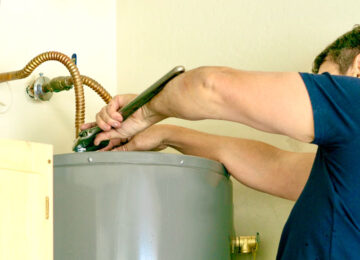Do you want to reduce your water heating costs? Water heaters account for roughly 18% of a homeowner’s total energy cost. Learn how to make your home more energy-efficient. Having hot water in our homes is something that many people take for granted. Showers, clean dishes, clean clothing, and other creature comforts linked with hot water are all part of our everyday existence.
Water heating is the second-largest energy expense in most homes after lighting, accounting for about 18% of total household fuel use. Water heaters account for roughly 90% of the energy cost related to your hot water system.
Here are some money-saving water heating suggestions that will save you a bundle on your next water heating bill.
1. Reduce Water Heater Usage
Between showers, washing dishes, doing laundry, and other activities around the house, it’s common to see a large amount of hot water go down the drain before it ever gets used up. Dishwashers offer some energy savings especially when paired with high temperature washes (180 degrees Fahrenheit or higher) rather than using cold washcold rinse cycles. If hot water is necessary, always fill up the dishwasher and use a high-temperature setting.
2. Water Heating System Sizing
Choosing a water heater that’s too big means it has to work harder and waste energy heating more water than you actually need and will ultimately lead to higher utility bills. Water heaters usually come in sizes of 30, 40 or 50 gallons. Water heaters are often sold as packaged units with storage tanks already installed so they can be easily transported from store to home. When using a Water Heater Size Calculator, input your family’s daily hot water usage as indicated by “Per person per day” this includes any visitors you might have over during the year that would use water too! The average household usage is 20 gallons per person per day.
3. Water Heater Temperature
You can save energy by setting your water heater temperature lower when you do not require hot water at its full capacity, for example when taking a shower or washing the dishes. Water heaters typically have two settings: regular and low-energy. Water heating appliances sold in the United States must have a thermostat that allows you to set the maximum temperature on 120 volts or 240 volts systems to no more than 199 degrees Fahrenheit (93° C). To determine if your current water heater has this feature, check your owner’s manual before trying any other method of adjusting your water heater’s set point. If it does not have flexible burner control/adjustable set point, do not try to manipulate the thermostat as it may be a safety hazard.
4. Water Heater Temperature Set Back
Keeping your water heater at its maximum temperature will stimulate bacterial growth and consume more energy as the heater has to reheat each time someone turns on hot water faucet. It is recommended that you set your water heating appliance no more than 120 degrees Fahrenheit, which means dropping the setting from 140 degrees Fahrenheit down to 120 degrees Fahrenheit. Your monthly savings can range from $10 – $20 per month for a family of four depending upon local fuel prices and the extent of any existing insulation in your tank-type unit. Note: Water heaters with tankless electric hot water heaters do not suffer from this problem because they do not store hot water, but rather heat it on demand.
5. Water Heater Insulation
Standing in the hot shower with cold air blowing all around is not exactly an enjoyable experience! Installing insulation around your tank-type water heater can help reduce the amount of hot water lost through its exterior surface. This is most effective with gas or diesel-fueled units that have large metal tanks that are subject to high amounts of heat loss. Water heating appliances sold in the United States must have a minimum level of insulation, typically R-10 for vertical models and R-19 for horizontal models, based on whole-tank surface area. For home use, fiberglass or foam board insulating blankets can be used to achieve this effect. Water Heater Blanket
6. Water Heater Drain
Water heaters are susceptible to corrosion and the accumulation of sediment over time, which can lead to leaks or even gas or fire hazards. Water heater manufacturers recommend draining water heaters every 6 months with an approved method such as Suburban Water Heaters’ Water Heater Drain . If drain access is not available, you can fill hot water tank with a mixture of 50% household bleach and 50% water to kill bacteria that may be present in hot water system. Note: Do not open your hot water heater’s pressure relief valve when draining the unit; this is only done at professional service centers. You should never use chemicals inside a hot water heater except those specifically designed for this purpose. Water and electrical components in a hot water tank can result in an electric shock, overheat the water heater and cause damage to the internal parts.
7. Water Heater Wrap
Another method of increasing energy efficiency is by wrapping your water heating appliance with energy-saving insulation . This will reduce heat loss from the unit’s exterior surface as well as increase its life expectancy. Installation takes about one hour per 40-gallon hot water tank at a cost of roughly $50 – $75 for materials plus an additional fee to have it professionally installed if you choose not to perform this task yourself.
Another method of saving energy on hot water heating is by using an insulation blanket. Insulating materials can be wrapped around your existing hot water heater to help reduce heat loss from its exterior surfaces, which in turn saves you money. Water heater insulation kits are available at home improvement retailers and pay for themselves within a year or two based on fuel savings alone. W
Reducing the amount of heat lost from a hot water tank’s exterior will save you money! There are several types of insulation that can be applied to your tank-type hot water appliance such as fiberglass sheets, fire wraps and even low-cost towels. Water Heater Blanket.
Other Tips
A relatively simple way to save money on hot water heating is by lowering your household’s overall hot water usage . For instance, instead of taking two or more showers back-to-back, consider turning off shower and waiting 5 minutes before turning it back on (this will allow enough time for pipes to refill with hot water).
Another way to reduce energy costs associated with having hot water in our homes is by using Energy Star appliances whenever feasible such as Energy Star Water Heaters which are available at home improvement retailers. Water heaters that feature the Energy Star logo meet strict energy efficiency guidelines set by the U.S. Environmental Protection Agency and Department of Energy.
Lastly, if you are interested in reducing your overall energy consumption and hot water heating costs even further, one option is to purchase a tankless hot water heater . Water heaters that do not store adequate amounts of hot water (e.g., traditional tank-type) tend to be more expensive to operate than their tanked counterparts due to their smaller storage capacities (therefore requiring more frequent re-heating cycles).
For more information or help with maintaining your hot water heater, Contact Us today!



